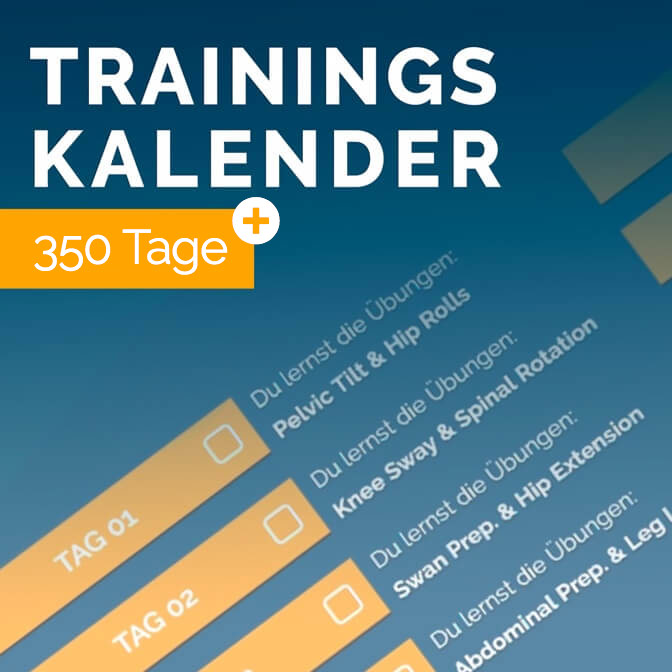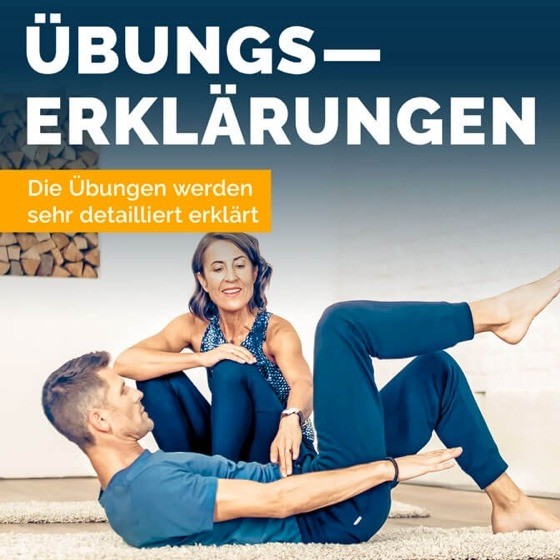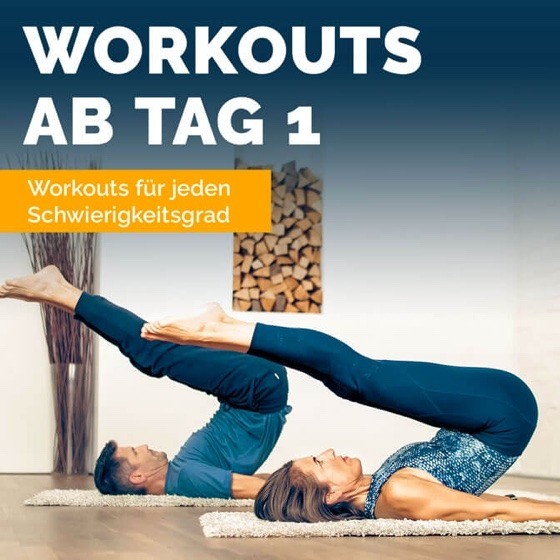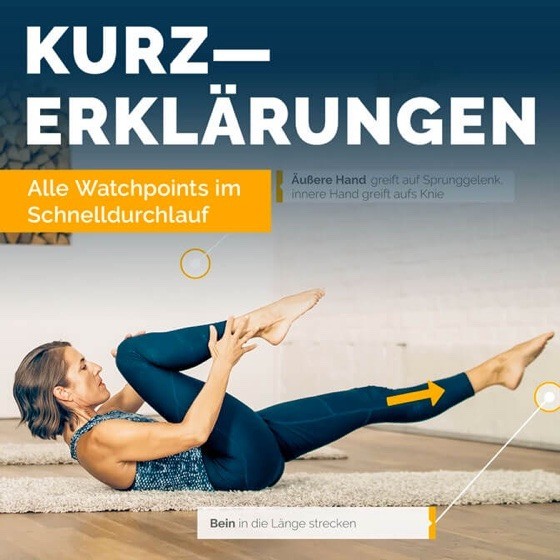
Pilates explained
Who was Joseph Pilates (really)?
December 09, 2023, by Maria Felsner
Content
- Pioneer of body art
- From internment to innovation
- Clara Pilates
- Contrology
- Animal Elegance
- Reformer, Cadillac, Wunda Chair
- Pilates small equipment
- Modern Pilates small equipment
- An example of the healing power of Pilates
- Joseph Pilates' fight for recognition
- The magic of silence
- The studio on Eight Avenue
- Preserving the heritage
- Modern adaptations
- Conclusion
- Sources & other articles that might interest you
Joseph Pilates
Pioneer of body art
Joseph Pilates, the future founder of the famous Pilates Method, was born in Mönchengladbach on December 9, 1883.
Growing up in a home characterized by physical fitness and health - his father was an award-winning gymnast and successful beer brewer - Pilates' life was shaped by sport from an early age.
In addition to gymnastics, his father also gave him an insight into the art of brewing, which strengthened his appreciation of craftsmanship and precision.
His family connection to sport and the personal health challenges of his childhood, including asthma, rickets and rheumatic fever, motivated him to strengthen his body and improve his health.
Despite these adversities, which may have included the loss of an eye, Joseph experimented with various sports such as gymnastics, diving and boxing.
This wealth of experience will later be incorporated into the development of his holistic training method, which will be characterized by the harmonious connection of body and mind.
Joseph Pilates in England
From internment to innovation
Joseph Pilates came to England (under certain circumstances) for professional reasons. There, in 1912, he decided to pursue a career as a boxer, which also led him to perform in the circus.
John Howard Steel challenges this version of the story of Joseph Pilates in his book "Caged Lion: Joseph Pilates and His Legacy" and presents a well thought out, very exciting story for the reasons for Joseph's stay in England....
However... at the outbreak of the First World War, Pilates was interned as an "enemy alien" due to his German nationality. During his internment in a camp on the Isle of Man, he took the opportunity to implement his ideas for improving the health and fitness of his fellow prisoners as a nurse.
However, the widespread assumption that Pilates developed the idea for his device, later known as the "reformer", during his internment on the Isle of Man by experimenting with bed springs is controversial.
There is evidence that the conditions in the camp were very spartan, with hard straw beds, which casts doubt on the theory of the use of springs.
The exact genesis of the reformer and the role played by the storage conditions are therefore not clearly understood.
However, Pilates' time on the Isle of Man was an important phase in his development. By consistently training with his fellow prisoners, he soon realized how his specific physical exercises not only improved their health and fitness, but also contributed significantly to their mental fitness and made them more resilient despite their captivity.
It is worth noting that there are few documented sources about Pilates' time on the Isle of Man. Most of the information is second-hand or from later reports, making it difficult to paint a complete picture of his activities and developments during this time.
In any case, this time was decisive for the development of the Pilates method.
After the war, Pilates returned to Germany, where he also worked as a self-defense trainer at the Hamburg Police School.
He emigrated to the United States in 1926. Pilates met Clara on his journey to the USA.

Clara Pilates
Who was Clara?
Clara Pilates, born Clara Zeuner, was a trained nurse and shared Joseph's interest in physical fitness and health. Their meeting on the cruise led to a deep professional and personal bond.
Although Clara is often referred to as Joseph Pilates' wife, there is some confusion about the exact legal status of their relationship.
Some sources claim that they were actually married, while others suggest that they had a lifelong partnership without formally marrying.
However, in the book "Caged Lion: Joseph Pilates and His Legacy" by John Howard Steel, a student and friend of Joseph Pilates, it is mentioned that Steel advised Jo Pilates to marry Clara.
Steel, who was a lawyer by profession, gave this advice for legal reasons. At the time, Jo and Clara were already working together in their studio in New York, and their marriage provided them with legal and financial security, particularly in relation to the business and the legacy of Pilates' methods and teachings.
However, the marriage not only strengthened their business partnership, but also manifested their personal relationship. Clara played a decisive role in the development and dissemination of the Pilates method.
Their partnership has been central to the establishment and success of Pilates on both a personal and professional level.
Clara continued to run the studio after Joe's death, helping to secure the foundations of the method for future generations of Pilates teachers and practitioners and establishing it as a central system for physical training and rehabilitation.
Contrology
What did Joseph Pilates call his training method?
Joseph Pilates originally called his method "Contrology". This name reflected his conviction that his method enabled complete control of the body through the mind.
For him, "Contrology" was a comprehensive concept that emphasized the idea that mind and body must work together to achieve optimal health and mobility.
The name "Pilates" as we know it today only became popular after the death of Joseph Pilates. It is an afterthought that was used by his students and followers to honor his method and distinguish it from other body training systems.
This renaming took place mainly in the late 1960s and 1970s, when his techniques gained popularity, especially in the US dance community.
The method retained the basic principles and exercises developed by Joseph Pilates, but the name "Pilates" helped to establish it as an independent and recognizable form of physical training.
Animal elegance
Nature and objects as a muse for Pilates exercises
Joseph Pilates was known for studying the natural movements and movement sequences of animals and drawing inspiration from them.
His observations of animals in the zoo and his experience as a circus performer may have contributed to the naming of his exercises. Animals often move in efficient, graceful and powerful ways, which Pilates possibly saw as ideal examples of human movement.
The use of animal names for exercises such as "Seal" (seal) or "Swan Dive" (diving swan) could indicate that he wanted to emphasize the specific qualities of these animals - such as balance, agility and strength - in the corresponding exercises.
By imitating these animal movements, humans can improve their own body control.
It is also possible that the animal names help practitioners to better visualize and perform the movements by creating a visual and kinesthetic connection to the names.
The intuitive idea of how an animal moves can improve the quality of the execution of an exercise and at the same time introduce an element of lightness and play into the training.
Even today, Pilates instructors still use figurative language - for example, detaching the spine from the mat like a string of pearls when doing roll-ups or hip rolls.
The exact reasons for the naming are not fully documented, and many of the names in use today may have been introduced later by his students or other Pilates teachers.
In each case, the names reflect the connection between nature, objects, animals and human movement, which is at the heart of the Pilates method.
In 1934, Pilates published the book "Your Health", in which he explained the basic principles of balance between body and mind. This was followed in 1945 by "Return to Life Through Contrology", in which he presented 34 floor exercises designed to strengthen the reader's body.
These exercises reflect the core principles of Pilates' approach to body conditioning and involve a combination of strength, flexibility and mental control.
Joseph Pilates' 34 original exercises, which form the basis of classical Pilates training, are still taught in this exact order in some schools today. They are designed to strengthen and stretch the body holistically, with the focus on the core.
Here is a brief description of the exercises:
- The HundredLying on your back, legs raised and arms pulsating, to strengthen the abdominal muscles.
- The Roll-UpSlowly straighten up from the supine position and bend forward over the legs to stretch the spine.
- The Roll-OverSwing your legs over your head and roll your spine.
- The One Leg CircleOne leg circles while the other lies flat on the floor.
- Rolling Back: Rolling backwards and balancing in a seated C-Shape.
- The One Leg StretchAlternating stretching of the legs while lying down.
- Double Leg StretchStretch and pull both legs together.
- The Spine Stretch: Sitting, with legs and spine straight-Elongation.
- Rocker with Open LegsRolling backwards with open legs and keeping your balance.
- The Corkscrew: Circle your legs while lying down to mobilize the spine.
- The Saw: In a sitting position, reach over your legs and rotate your spine.
- The Swan-DiveChest lift from the prone position to strengthen the back.
- The One Leg KickProne position, bend and straighten one leg.
- The Double Leg KickBend and stretch both legs in the prone position.
- The Neck Pull: Pulling the head while sitting, similar to rolling-Up.
- The Scissors: Raise and lower one leg while lying down.
- The Bicycle: Cycling in supine position.
- The Shoulder BridgeRaise your hips and straighten one leg.
- The Spine TwistSeated rotation of the spine with arms outstretched.
- The Jack Knife: Raise your legs over your head and then lift into a V-Position.
- The Side Kick: Side leg raise in lateral position.
- The Teaser: V-Raise the seat from the supine position.
- The Hip TwistHip circles in a seated position with legs straight.
- SwimmingFloating movements in prone position.
- The Leg Pull Front: Support position and raise leg.
- The Leg PullSupine position, lift your hips and raise your leg.
- The Side Kick KneelingLateral kick in a kneeling position.
- The Side BendLateral stretching while standing or sitting.
- The BoomerangRollers and legs cross in a complex sequence.
- The SealRolling like a ball with arms crossed.
- The CrabRolling backwards with legs crossed.
- The Rocking: Prone position, back bends and rocking.
- The Control BalanceBalance on your shoulders and control your legs.
- The Push-UpPilates version of the push-up with walking movement.
Pilates equipment
Reformer, Cadillac, Wunda Chair & more: insights into Pilates equipment innovations
Joseph Pilates was not only a pioneer in the field of physical training, but also a true visionary in the development of training equipment.
These devices, developed from his observational skills and understanding of human biomechanics, revolutionized the way we think about physical training and rehabilitation today.
They were way ahead of their time and still form the basis of modern Pilates studios today.

Reformer
History & vision of Joseph Pilates
Joseph Pilates developed the reformer in the 1920s. Originally called the "Universal Reformer", it was a central element in his concept of "Contrology", the forerunner of modern Pilates. Pilates saw the reformer as a device that strengthened the body holistically and improved flexibility.
The Reformer was originally designed for training dancers and athletes and aimed to strengthen the deep muscles and improve movement coordination on multidimensional levels.
Modern application
Today, the Reformer is used in Pilates studios all over the world. It enables a variety of exercises and is used for group and individual training.
The modern reformer has evolved in design and functionality, but retains the basic principles of Pilates.

Cadillac (formerly trapezoidal table)
History & vision of Joseph Pilates
The Cadillac was originally called the "Trapeze Table" and was designed both for athletes for acrobatic exercises and as a rehabilitation device.
Pilates used the Cadillac to enable a wide range of movements on multidimensional planes and in particular to strengthen the spine and joints. Numerous overhead movements enabled clients to gain a new perspective on flexibility and strength.
Modern use
Today, the Cadillac is standard equipment in many innovative Pilates studios. Even today, it is still mainly used in individual training, as acrobatic and rehabilitative exercises are often performed here.
A contemporary innovation is the combination of Reformer and Tower, known as the Reformer Tower. This combination saves space and makes it possible to use a large part of the Cadillac and Reformer exercise repertoire, which significantly increases the variety of possible exercises and makes the equipment more affordable and versatile.

Wunda-Chair (Pilates chair)
History & vision of Joseph Pilates
The Wunda Chair was designed by Pilates as a multifunctional piece of equipment for his clients at home, which could serve both as a training tool and as everyday furniture. This reflected Pilates' philosophy that exercise and fitness should be integrated into everyday life.
Pilates used the Wunda Chair to strengthen the core muscles and improve the balance and coordination of his students.
Modern application
In modern practice, the Wunda Chair is particularly popular in smaller studios or for home use. It offers an efficient full-body workout and is ideal for isolating and training specific muscle groups.

Ladder Barrel
History & vision of Joseph Pilates
Joseph Pilates developed the Ladder Barrel with the aim of promoting flexibility, strength and coordination.
The device consists of a curved, padded lying surface (the Barrel) and a ladder-like structure (the Ladder). Pilates' vision was to create a versatile training device that would enable stretching and strengthening exercises for the spine in particular, as well as upside-down exercises.
Modern use
Today, the Barrel is increasingly used in professional sports, especially by gymnasts and dancers. These athletes benefit from the targeted support provided by the device to improve their core strength, flexibility and balance - skills that are of great importance in their disciplines.
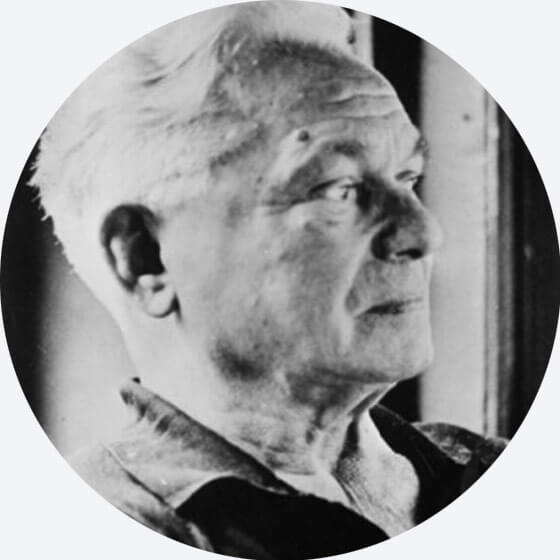
"The goal of Pilates is to have the whole body in mind so that the body becomes as supple as a cat's, not as muscular as a brewer's horse."
JOSEPH PILATES
Pilates small equipment
Insights into the small equipment designs of Joseph Pilates
In addition to the large pieces of equipment mentioned above, Joseph Pilates designed a number of other interesting and very useful small pieces of equipment that are still very well known today and are just as central to his method.
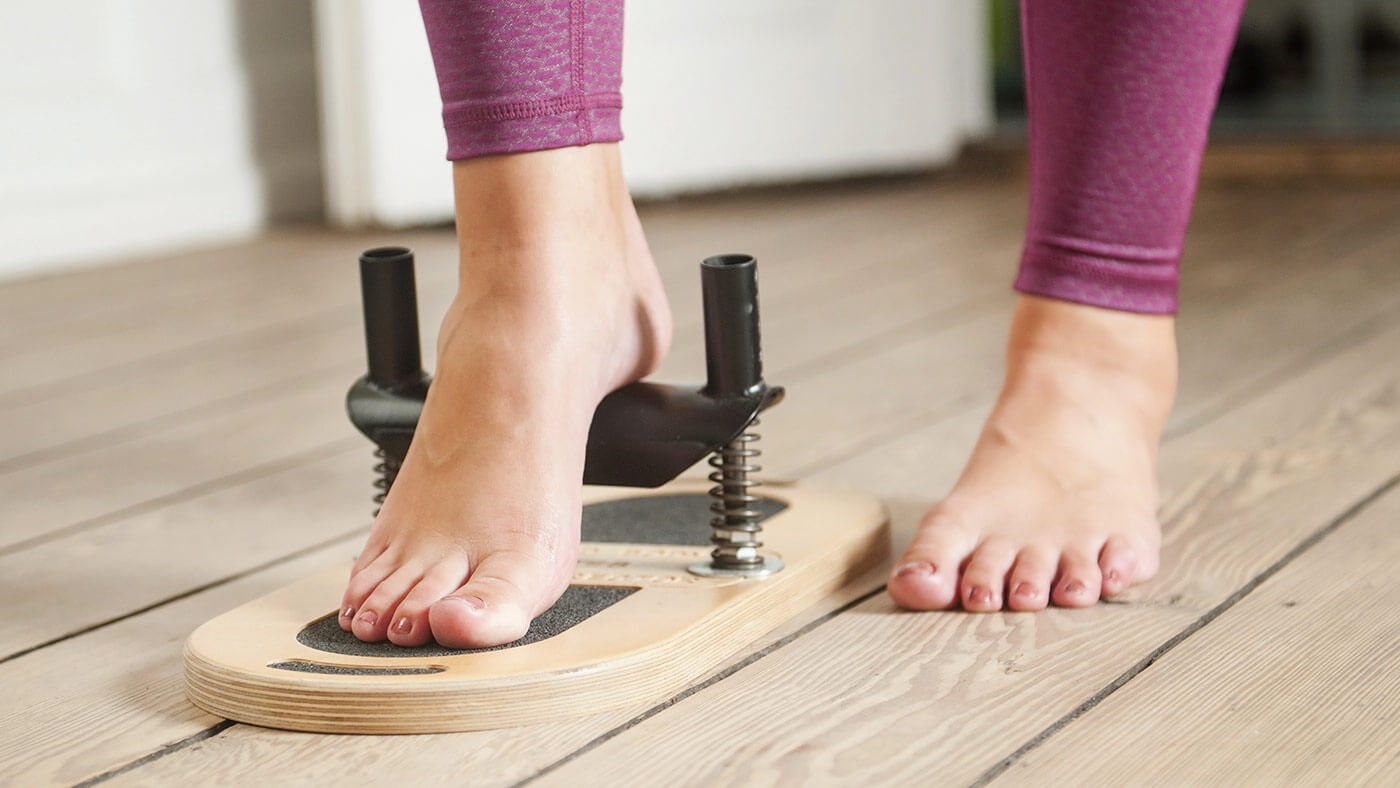
Foot Corrector
History & view of Joseph Pilates
The Foot Corrector, which Joseph Pilates developed in the early 1920s, is a testament to his innovative strength. Pilates intended to patent this device, which underlines its revolutionary significance.
It consists of a platform with integrated springs, which were probably inspired by bed springs. The Foot Corrector was designed to strengthen the foot muscles and stabilize the ankles.
Modern application
Today, the Foot Corrector has established itself in high-quality Pilates studios worldwide. Under the guidance of qualified trainers, it is used in individual training sessions to treat specific foot problems such as hallux valgus, splayfoot and flat feet.
The individual adaptation of the exercises enables targeted correction of foot misalignments and supports the strengthening of the leg muscles.
Magic Circle (Pilates ring)
History & view of Joseph Pilates
The Magic Circle, also known as the Pilates Ring, was made by Pilates from the steel of a beer barrel. As a result, the circle was originally much stronger and more resistant than many of today's modern versions.
Pilates saw this device as a way to support women in particular with their pelvic floor and core muscles.
Through targeted exercises with the Magic Circle, women were able to develop their inner strength and increase stability in the pelvic area. This not only had an effect on physical fitness, but also on sexual health and well-being.
Modern application
Today, the Magic Circle is used in Pilates practice not only by women, but by all exercisers. It is a versatile piece of equipment that is used to strengthen the shoulder girdle, arms, legs and hip muscles.
Its versatility and effectiveness in improving muscle strength and stability have contributed to its enduring popularity.
Spine Corrector (spinal column corrector)
History and view of Joseph Pilates
The Spine Corrector, also known as the "Pilates Step Barrel" or "Hump Back", was developed by Joseph Pilates to promote and correct the mobility of the spine.
Made of wood and often upholstered, the device has a unique crescent shape.
Modern application
The Spine Corrector is very popular in modern Pilates practice as it offers an effective way of performing deep stretches and strengthening exercises.
A somewhat lesser-known device from this period was the Pedi-Pole...
The Pedi-Pole (Pilates Bar)
A vertical device consisting of a bar with springs at the top, designed to improve posture, strengthen the upper body and promote flexibility of the spine.
This is just a small selection of the many small pieces of equipment that Joseph Pilates originally developed. Even today, many Pilates machines are still being developed, although they are not directly based on his designs.
Modern Pilates small equipment
Modern Pilates small equipment
These devices and their use today show how the visionary ideas of Joseph Pilates still form the basis of modern Pilates.
Pilates roll
For self-massage, to improve mobility and for balance exercises.
Flexbands/resistance bands
They serve to increase muscle strength and flexibility.
Pilates balls
Small balls that provide additional resistance and stability.
Although the equipment has evolved in design and technology, the basic principles of Pilates - control, precision and full-body movement - have remained unchanged. They are proof of the timelessness and effectiveness of his method.
An example of the healing power of Pilates
Eve Gentry
One of the most impressive stories in the Pilates world is the collaboration between Joseph Pilates and Eve Gentry, a famous dancer.
Gentry was diagnosed with breast cancer and had to undergo a mastectomy, which severely restricted her mobility. During this difficult phase of her life, she turned to Joseph Pilates.
Pilates worked intensively with Gentry and used his innovative methods and equipment. He adapted different equipment and used his holistic approach to restore Gentry's mobility in the shoulder girdle as well as her strength and coordination.
The results of this collaboration were remarkable. Eve Gentry not only regained her flexibility, but was also able to dance and teach professionally again - impressive proof of the effectiveness and versatility of the Pilates method.
This story is not only an inspiring example of overcoming obstacles, but also a testament to the therapeutic applications of the Pilates method that go far beyond fitness training.
Joseph Pilates' fight for recognition
A story of disappointment and hope
Over the years, my image of Joseph Pilates has changed fundamentally.
While I initially thought he was a rather secretive, taciturn and extremely precise trainer, reading John Howard Steele's 'Caged Lion' revealed a completely different side to his personality.
For me, this book was the key to realizing that Pilates was much more than a pioneer with strict methods. He was a person with a deep empathy and a holistic approach whose innovative spirit went far beyond what was generally known.
I would like to share my new view of Pilates, shaped by Steele's insights, with my readers here in order to paint a complete picture of an extraordinary man who is often misunderstood.
The book also sheds light on his disappointment that neither his colleagues in bodywork, medicine nor therapists ever recognized his "Contrology" training method. This non-recognition depressed him until his death.
"Caged Lion" also shows how important it was for Clara Pilates to continue the Pilates method together with John Howard Steel, the author of the book, after the death of her husband.
The trainers of the first generation who had worked with Joseph Pilates were often reluctant or did not want to be involved in further development. Nevertheless, Clara and John managed to keep the method alive to this day.
Below are some details and excerpts.
The magic of silence
The magic of silence
In his book "Caged Lion", John Howard Steel describes how Pilates' often taciturn teaching style both irritated and fascinated his clients.
This approach created a deep connection to regular exercise, an almost addictive routine that bound people to Pilates.
His quiet empathy and his offer to help at affordable prices demonstrate a deep understanding of human needs.
The studio on Eight Avenue
A reflection of the master

Pilates' studio on Eight Avenue in Manhattan was more than just a training space, it was a symbol of his commitment and philosophy.
Ascetically furnished, it reflected his modest but deeply committed nature.
Despite the success of his method with many clients, he was not recognized by orthopaedists, colleagues and doctors, a disappointment he had to struggle with until his death in 1967.
Preserving the heritage
Clara, John Howard Steel and the first generation
Clara Pilates and John Howard Steel played a crucial role in keeping the legacy of Joseph Pilates alive.
They were the pillars that preserved and spread his techniques after his death. Students of the first generation, such as Romana Kryzanowska, have helped to ensure that the classic Pilates method is still taught today.
This story shows how profound and lasting the influence of a single person can be.
Modern adaptations
A living legacy
Today, in a constantly changing world, Pilates training must be adapted to current needs and lifestyles.
It is important to keep the spirit of Joseph Pilates alive while pursuing new, holistic approaches. Your own approach reflects this need by using innovative methods that take into account not only the body, but also the mind and soul.
Taken together, these insights provide a more comprehensive picture of Joseph Pilates, a man who was far more than just a fitness guru.
He was an inventor, thinker and visionary whose influence on the world of physical training can still be felt today. His equipment, methods and philosophical ideas have inspired generations of trainers and athletes and are still an essential part of the fitness and wellness industry.
Conclusion
More than just exercise - a philosophy of life
Joseph Pilates left us more than a series of exercises; he created a philosophy of body awareness that continues to inspire generations after him.
By appreciating his legacy and developing his methods, we not only honor his memory, but also enrich our own lives and those of our fellow human beings.
If you want to find out more about what really killed Joseph Pilates and what his last days were like, you can find the answer in John Howard Steel's book.
I hope I have been able to give you some insight into the life and character of Joseph Pilates.
For me personally, it is a great honor to have walked this path. I am infinitely grateful that I can practise this art with you here at the Pilates Club and that I can also run a small studio myself, where I have learned how to use all this training equipment over the decades.
PS: With our Pilates training calendar you can easily integrate regular Pilates training into your everyday life and stay motivated.
Sources & other articles that might interest you
A better body awareness through Pilates
Books by Joseph Pilates:
- Return to Life Through Contrology: In this book, Pilates presents its exercises and philosophies and lays the foundation for modern Pilates practice.
- Your Health: A Corrective System of Exercising That Revolutionizes the Entire Field of Physical Education: Here Pilates shares his thoughts on health and fitness and offers insights into his training methods.
Sources:
- * https://www.vitapilates.co.uk/2017/10/26/who-was-joseph-pilates/#:~:text=Therearetwoversionsof,histrouAllPostspe
- ** https://www.pilatescollectivedenver.com/blog/back-to-basics-joseph-pilates#:~:text=Theformisknowknown,ideasandtrainedother
- *** https://en.wikipedia.org/wiki/Joseph_Pilates#:~:text=Pilateswasoriginallyagymnast,InternmentduringWorldWarI

